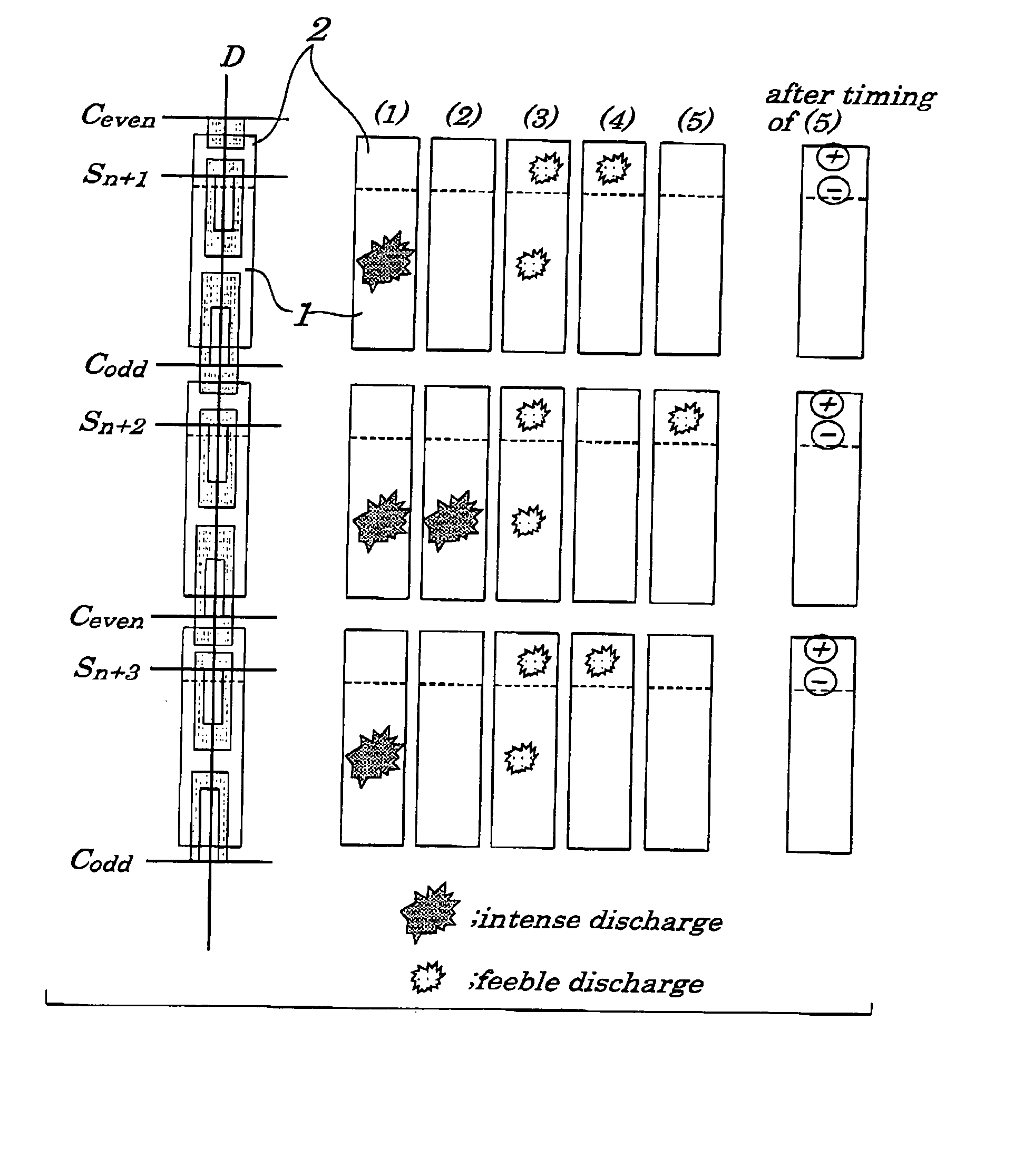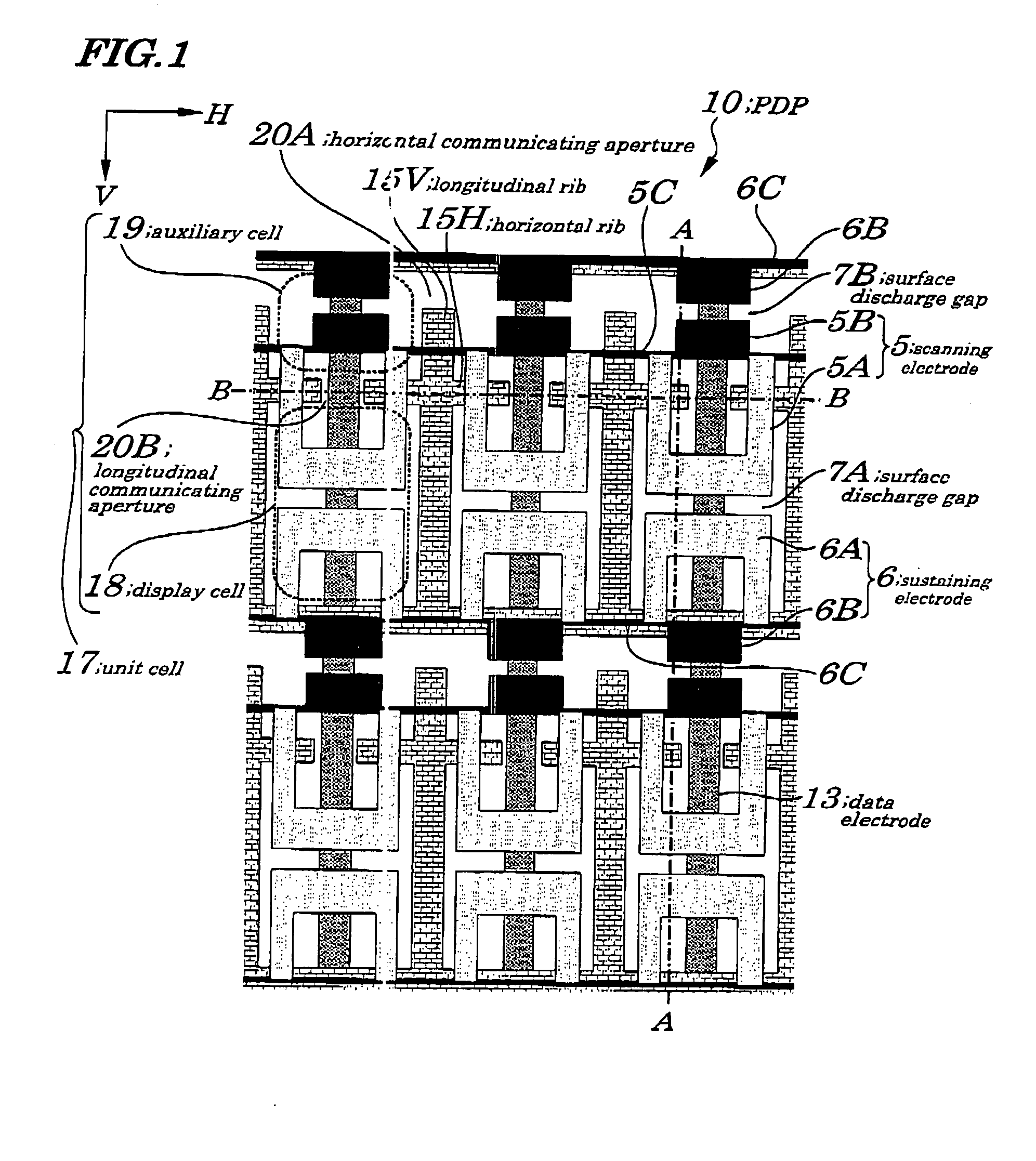Plasma display device and method for driving same
a display device and plasma technology, applied in the direction of electrodes, identification means, instruments, etc., can solve the problems of unresolved problems, large ratio of scanning period tb>2/b> to period in each sub-field ts, and improvement of light-emitting luminance, etc., to achieve shortening the scanning period, improving the image quality, and increasing the cost
- Summary
- Abstract
- Description
- Claims
- Application Information
AI Technical Summary
Benefits of technology
Problems solved by technology
Method used
Image
Examples
first embodiment
[0076]FIG. 1 is a plan view schematically showing configurations of a PDP 10 making up a main component of a plasma display device of a first embodiment of the present invention. FIG. 2 is a cross-sectional view of FIG. 1 taken along a line A-A. FIG. 3 is a cross-sectional view of FIG. 1 taken along a line B-B. FIG. 4 is a cross-sectional view showing an example of a partially modified configuration of the PDP shown in FIG. 1 taken along a line B-B. FIG. 5 is a diagram showing waveforms of a voltage applied during a pre-discharging period when the PDP 10 of FIG. 1 is driven. FIG. 6 is a diagram showing waveforms of a voltage applied during a scanning period when the PDP 10 of FIG. 1 is driven. FIG. 7 is a diagram showing waveforms of a voltage applied during a sustaining period when the PDP 10 of FIG. 1 is driven. FIG. 8 is a plan view schematically illustrating operations of the PDP 10 of FIG. 1 during the pre-discharging period when the PDP 10 is driven. FIG. 9 is a plan view sche...
second embodiment
[0092]FIG. 13 is a plan view schematically showing configurations of a PDP 21 making up a main component of a plasma display device according to a second embodiment of the present invention. Configurations of the PDP 21 of the second embodiment differ greatly from those employed in the first embodiment in that a place where a longitudinal communicating aperture is formed is changed and a shape of a transparent electrode is changed. The PDP 21 making up a main component of the plasma display device of the embodiment is so configured, as shown in FIG. 13, that a longitudinal communicating aperture 20B is formed at an end of a display cell 18 and, in the display cell 18, an L-shaped transparent electrode 5A′ making up a scanning electrode 5 and an L-shaped transparent electrode 6A′ making up a sustaining electrode 6 are arranged in a manner to face each other with a surface discharge gap 7A being interposed between the L-shaped transparent electrodes 5A′ and 6A′. Except these, the conf...
third embodiment
[0095]FIG. 14 is a plan view schematically for showing configurations of a PDP 22 making up a main component of a plasma display device according to a third embodiment of the present invention. Configurations of the PDP 22 of the third embodiment differ greatly from those employed in the first embodiment in that no horizontal communicating aperture exists and configurations of an auxiliary cell are changed. In the PDP 22 making up a main component of the plasma display device of the third embodiment, as shown in FIG. 14, such a horizontal communicating aperture 20A as employed in the first embodiment does not exist and, in an auxiliary cell 19, a belt-shaped bus base portion 5C making up a scanning electrode 5 and a belt-shaped bus base portion 6C making up a sustaining electrode 6 are arranged in a manner to face each other with a surface discharge gap 7B interposed between the belt-shaped bus base portions 5C and 6C.
[0096] By configuring as above, following effects can be obtaine...
PUM
 Login to View More
Login to View More Abstract
Description
Claims
Application Information
 Login to View More
Login to View More - R&D
- Intellectual Property
- Life Sciences
- Materials
- Tech Scout
- Unparalleled Data Quality
- Higher Quality Content
- 60% Fewer Hallucinations
Browse by: Latest US Patents, China's latest patents, Technical Efficacy Thesaurus, Application Domain, Technology Topic, Popular Technical Reports.
© 2025 PatSnap. All rights reserved.Legal|Privacy policy|Modern Slavery Act Transparency Statement|Sitemap|About US| Contact US: help@patsnap.com



